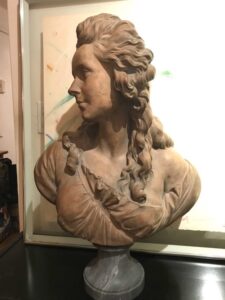 LM sent me a photo of a thirty inch tall terra cotta bust of a gorgeous young French female of the late 18th century. Her beauty is classic even today: flowing hair, effortless smile, full cheeks, upturned almond shaped eyes, a heart-shaped face. Madame Élisabeth Louise Vigée Le Brun (1755-1842), considered one of the most beautiful women of her time, became Europe’s most celebrated oil portrait artist. An original 1783 bust will bring $40,000. A 19th century reproduction goes for $4,000.
LM sent me a photo of a thirty inch tall terra cotta bust of a gorgeous young French female of the late 18th century. Her beauty is classic even today: flowing hair, effortless smile, full cheeks, upturned almond shaped eyes, a heart-shaped face. Madame Élisabeth Louise Vigée Le Brun (1755-1842), considered one of the most beautiful women of her time, became Europe’s most celebrated oil portrait artist. An original 1783 bust will bring $40,000. A 19th century reproduction goes for $4,000.
Notable sculptor of the time for portrait busts, Augustin Pajou (1730-1809), created this image of Vigée Le Brun. A portrait bust in clay was ‘la haute mode’ of the late 18th century. Many noble personages depicted in clay as a bust on a marble stand included Madame du Barry and Marie-Antoinette, also created by this celebrated sculptor.
At twenty-eight Vigée Le Brun sat for this bust created by Pajou to commemorate her admission into the Académie Royale de Peinture et de Sculpture in 1783. She became one of only five female artists admitted as an ‘academician’ during the course of fifty years of French painting. This allowed her to show her work at the Salons and Galleries of late 18th century France.
Vigée Le Brun Makes Connections
Because of her beauty, and position as a female portrait artist, a rarity, she garnered the attention of Marie-Antoinette. In the 1780s she became personal portrait painter to Marie-Antoinette and the Queen’s close confidant.
Vigée Le Brun became well connected, and well respected. The head of the British Royal Academy, Joshua Reynolds, called Vigée Le Brun one of the greatest portrait painters of all time. Although not recognized until the 20th century, Vigée Le Brun became the most important portrait painter of the Ancien Régime. In her career she painted 660 notable personages.
Her most notable works are portraits of herself and her daughter, Julie, nicknamed “Brunette.” The mother-daughter saga of how and why Vigée Le Brun documented Julie in her paintings is remarkable. In 1787 Vigée Le Brun caused a scandal at the Royal Academy, contravening all portraiture conventions. She painted a portrait of herself with a broad smile, showing teeth! And her three-year-old daughter, smiling too! Society considered a toothy smile scandalous in art, and a mother-daughter image as not “high” art.
In 1787 Vigée submitted three portraits of her daughter to the French Royal Academy. One portrayed Julie as the Goddess of Flowers, the same mythological creature abducted by Zephyr and lost to her mother. If Vigée foresaw the future, she picked the right goddess. Julie married against her mother’s wishes shortly thereafter, and parted company with her.
Vigée Le Brun’s own mother insisted she wed at age 20, but she’d painted portraits and earned her own money since age thirteen. So why marry? She did marry an older man, an art dealer, who enjoyed gambling and other women. She kept her maiden name. After fifteen years of marriage she asked for a divorce. She demanded her parent’s money, her bride dowry, back (unheard of) and remained single.
Living and Working in Revolutionary France
As a celebrity artist who painted titled individuals in the early 1780s people thought her on the ‘side’ of the monarchy, and an angry mobs pursued Vigée Le Brun in 1789. She escaped France with her daughter and nanny to Italy dressed in shabby clothing travelling in an old cart.
She quicky became the darling of any city she visited in Europe. Vigée Le Brun painted the great crowned heads of Europe for twelve years as an émigrée. While painting in Venice in 1793, France came to call on her again. Napoleon Bonaparte captured Venice and all Venetian bank assets, including Vigée Le Brun’s money.
In spite of a tumultuous existence, she lived a long life, returning to France to author books on her art and techniques. A remarkable artist, ahead of her time as both a painter and a woman, she had to wait for contemporary recognition until 1982. Her first retrospective was held at the Kimball Art Museum in Fort Worth. Her International Retrospective at the MET followed in 2016.